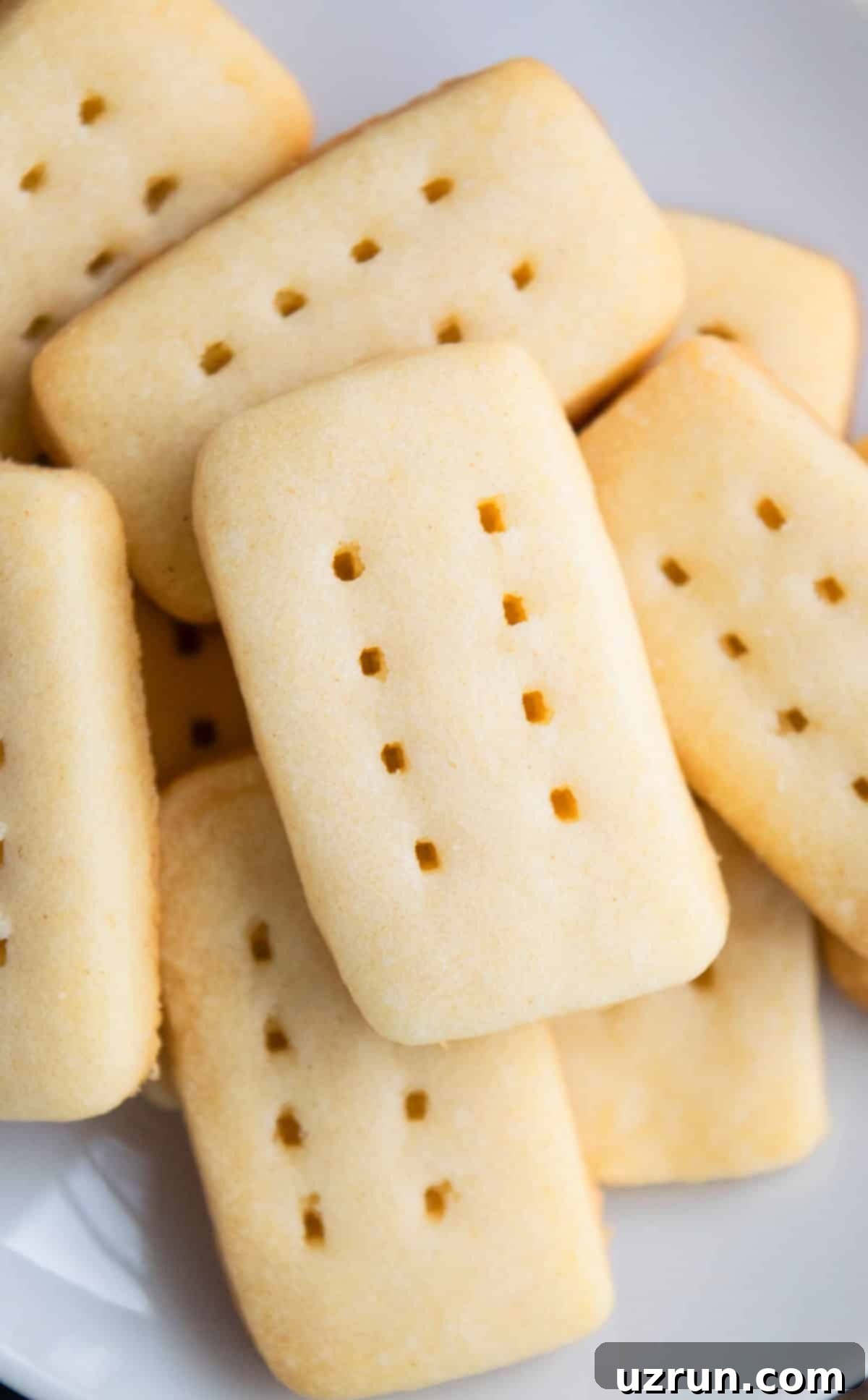Easy 3-Ingredient Classic Shortbread Cookies: Your Go-To Recipe for Buttery Perfection
There’s something truly magical about a perfectly baked shortbread cookie. Simple yet utterly irresistible, these buttery delights are a timeless classic that brings joy to any occasion. If you’re searching for the ultimate recipe to create soft, crumbly, melt-in-your-mouth shortbread cookies with minimal effort, you’ve found it. This old-fashioned, homemade recipe relies on just three fundamental ingredients – butter, powdered sugar, and all-purpose flour – to deliver an authentic taste and texture that will transport you straight to culinary bliss. It’s a quick and easy recipe that promises exceptional results every time.
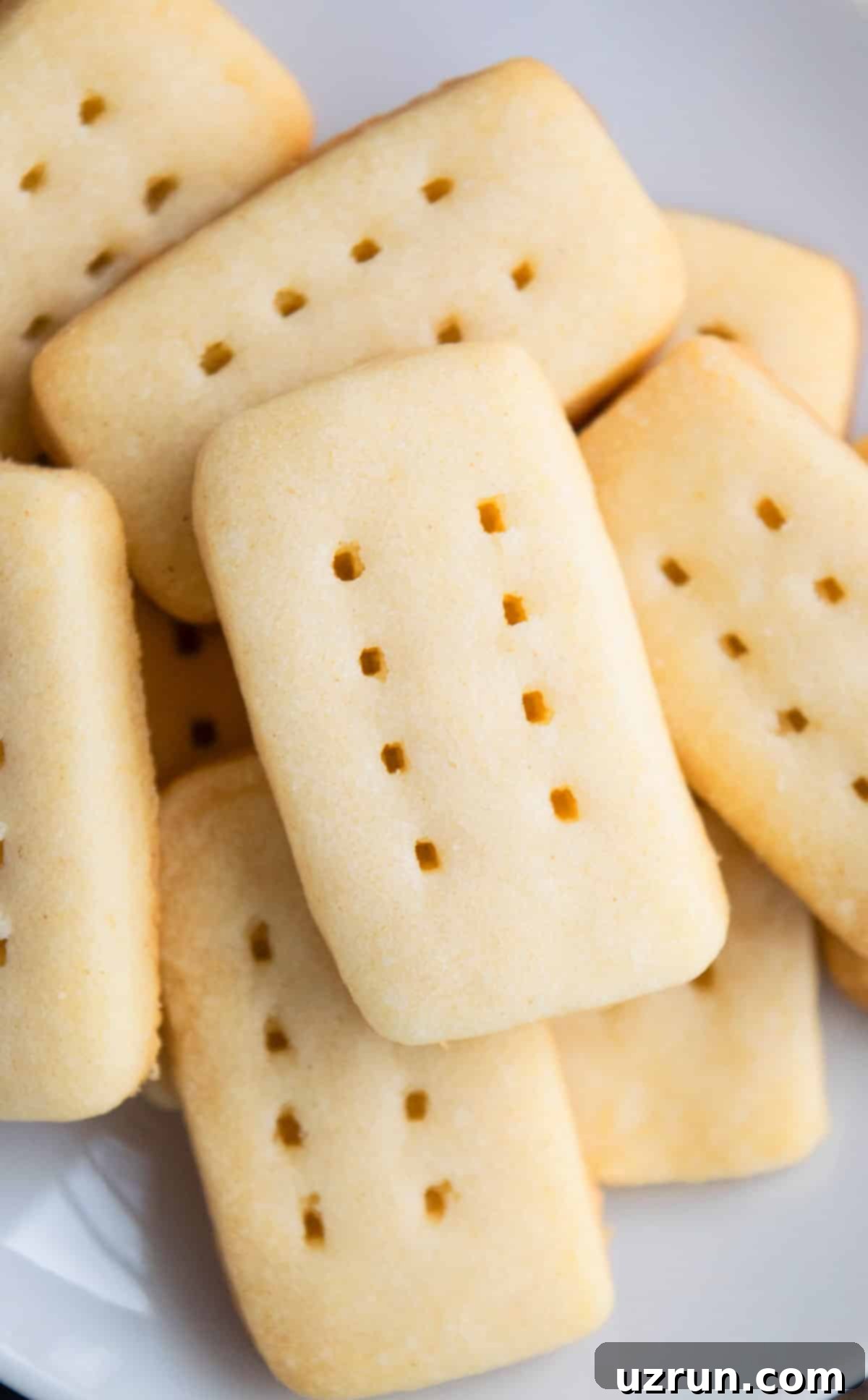
Often considered a festive staple, especially during the holidays, these classic cookies are beloved by families and friends alike. Their rich, buttery flavor and delicate crumb make them a perfect companion for a cup of coffee or tea, an elegant homemade gift, or a delightful treat all on their own. While they are phenomenal in their pure form, you can easily elevate them by dipping them in luscious chocolate, drizzling with a sweet glaze, or even turning them into adorable cookie sandwiches. Just like our popular Classic No Bake Cookies and Best Sugar Cookies (Small Batch), these shortbreads are guaranteed to become a cherished addition to your baking repertoire.
Dive into this straightforward guide and discover how to bake shortbread that’s not just good, but truly exceptional. We’ll cover everything from selecting the right ingredients to mastering the perfect baking technique, ensuring your cookies turn out beautifully soft, exquisitely buttery, and wonderfully crumbly every single time. Get ready to impress with these remarkably easy and delicious homemade shortbread cookies!
Essential Ingredients for Perfect Shortbread
Crafting perfect shortbread cookies hinges on selecting the right ingredients. With only three components, the quality and type of each play a crucial role in achieving that signature buttery flavor and tender, crumbly texture. Here’s what you’ll need and why:
- Butter: The Heart of Shortbread
For this recipe, we highly recommend using salted butter. The hint of salt truly enhances the sweet, rich flavor of the cookie, creating that authentic, well-balanced taste that shortbread is known for. If you only have unsalted butter on hand, that’s perfectly fine; simply add a small pinch (about 1/4 teaspoon) of fine salt to your dough along with the flour. It’s also vital that your butter is at room temperature. This allows it to cream beautifully with the sugar, incorporating air and creating a smooth, cohesive dough without overworking it. Cold butter will be difficult to combine, while melted butter will result in a greasy, dense cookie. - Powdered Sugar: For Unmatched Smoothness
Often called confectioners’ sugar or icing sugar, powdered sugar is absolutely essential for these shortbread cookies. Its fine, powdery consistency dissolves seamlessly into the butter, resulting in an incredibly smooth dough and a delicate, melt-in-your-mouth texture in the final baked cookie. This is distinctly different from granulated sugar, which would create a coarser texture and a less refined crumb. Do not substitute granulated sugar, as it will significantly alter the cookie’s characteristic tenderness. - All-Purpose Flour: The Structural Foundation
The only flour you need for this recipe is standard all-purpose flour. It provides the necessary structure without introducing unwanted chewiness or a dense texture. Unlike cakes or other cookies, shortbread doesn’t rely on leavening agents like baking powder or baking soda. The goal here is a dense, buttery crumb, and all-purpose flour helps achieve this beautifully. Avoid substituting with self-rising flour or other specialized flours, as their unique properties (like added leavening) will change the desired outcome.
These three simple ingredients, when properly prepared and combined, unlock the secret to shortbread cookies that are truly a cut above the rest. The quality of each ingredient shines through, so choose wisely!
Creative Variations to Elevate Your Shortbread
While classic shortbread is undeniably delicious on its own, its simple canvas makes it perfect for endless creative variations. Don’t hesitate to experiment with these ideas to customize your batch for any season, celebration, or personal preference:
- Add a Citrus Zest: Infuse your shortbread with bright, refreshing flavors. Mix in 1 teaspoon of finely grated lemon zest or lime zest directly into the dough with the flour. Once baked and cooled, you can drizzle the cookies with a simple lemon icing or this delightful Lemon Glaze for an extra burst of citrusy goodness.
- Make it Chocolatey: For chocolate lovers, stir in ½ cup of mini chocolate chips (dark, milk, or white) into the dough. Alternatively, after the cookies are fully baked and cooled, dip half of each cookie into melted chocolate or create an elegant drizzle over the tops for a beautiful finish.
- Add Colorful Sprinkles: Make your shortbread festive and fun! Mix in ¼ cup of small colorful sprinkles into the dough. For holidays or special events, swap in seasonal or holiday-themed sprinkles (like red and green for Christmas, or pastel for Easter) to match your celebration.
- Create Cookie Sandwiches or Thumbprints: Transform your shortbread into delightful sandwich cookies or classic thumbprints. Use your favorite fruit jams like cherry, raspberry, or our Easy Homemade Strawberry Jam as a filling. For thumbprints, simply press an indentation into the center of the unbaked cookies and fill with jam before baking, or after baking if using a richer ganache or frosting.
- Apply an Icing or Glaze: Once the cookies have completely cooled, spread a layer of creamy vanilla frosting or a simple sugar glaze (powdered sugar mixed with a little milk or water) on top. You can even tint the glaze with food coloring for extra visual appeal.
- Mix in Some Nuts: For added texture and a nutty flavor, fold in ¼ cup of finely chopped nuts such as almonds, pecans, or walnuts. Toasting the nuts lightly before adding them can deepen their flavor profile even further.
- Infuse with Herbs or Floral Notes: For a sophisticated twist, experiment with crushed dried herbs or floral elements. Rosemary adds an earthy note, lavender offers a delicate aroma, and even finely crushed dried rose petals can create a unique, fragrant cookie. Start with a small amount (½ teaspoon) and adjust to your taste.
- Cranberry Orange Option: A wonderful combination for the fall and winter seasons! Mix in ¼ cup of chopped dried cranberries and 1 teaspoon of fresh orange zest into the dough. The tartness of the cranberries beautifully complements the sweet butteriness of the shortbread and the bright orange.
- Add Some Color: If you’re baking for a kids’ birthday party, a themed event, or just for fun, use gel food coloring to tint the dough. Divide the dough into sections and color each one differently before rolling and cutting for vibrant, eye-catching cookies.
- Spiced Shortbread: Add 1/2 teaspoon of ground cinnamon, cardamom, or a mix of pumpkin pie spice to the flour for a warm, aromatic cookie perfect for cooler weather.
- Espresso Kick: For coffee lovers, dissolve 1 teaspoon of instant espresso powder in 1/2 teaspoon of hot water and add it to the butter and sugar mixture for a subtle coffee flavor.
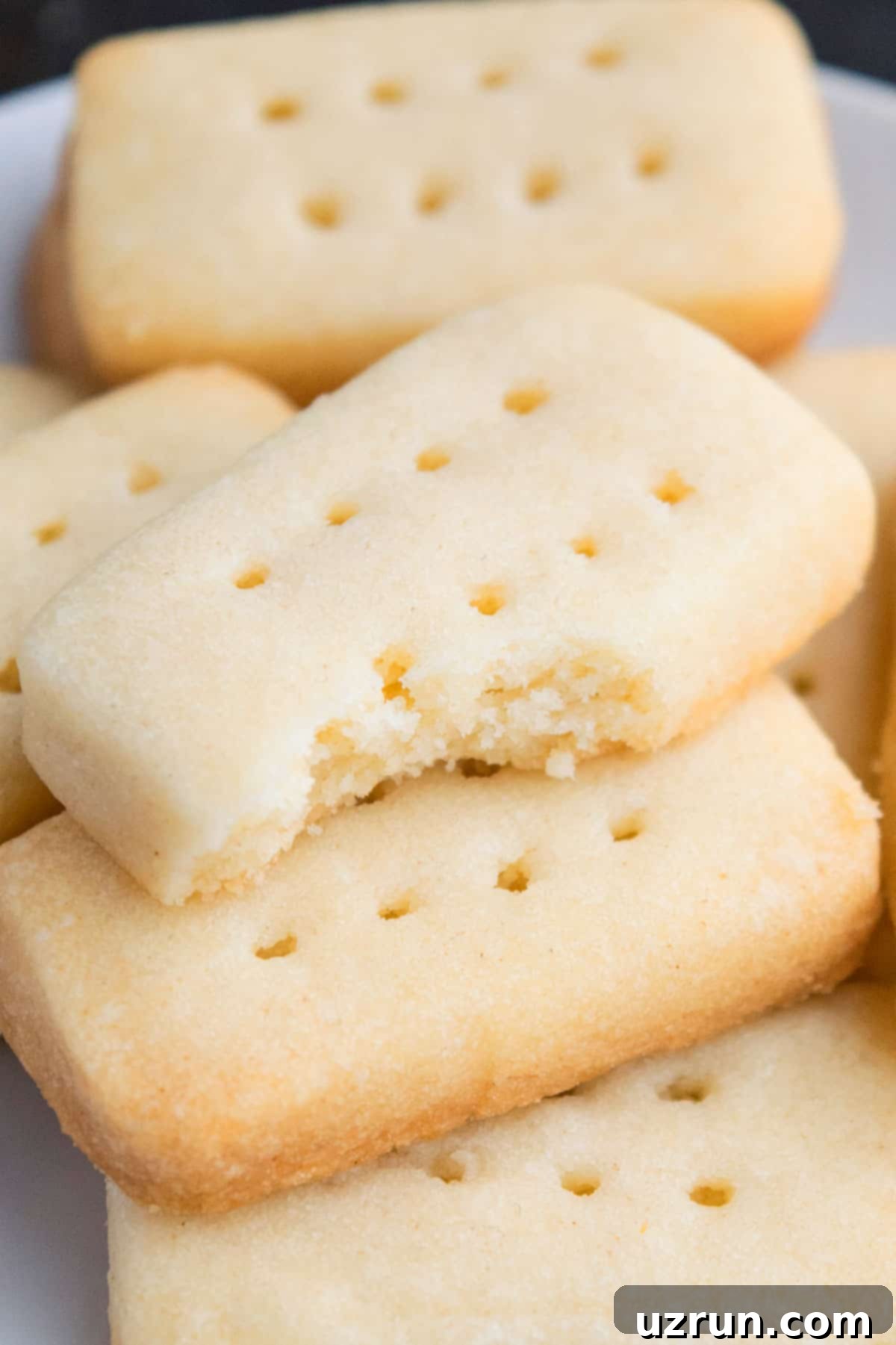
Step-by-Step Guide to Making Classic Shortbread Cookies
Making these delightful shortbread cookies is incredibly simple, requiring just a few key steps. Follow this process to achieve perfect, buttery results every time:
- Cream Butter and Sugar: In a large mixing bowl, using an electric mixer or stand mixer with the paddle attachment, cream together the room temperature salted butter and powdered sugar until the mixture is light, fluffy, and pale in color. This step is crucial for incorporating air and ensuring a tender cookie. Scrape down the sides of the bowl as needed to ensure everything is well combined.
- Incorporate the Flour: Gradually add the all-purpose flour to the creamed butter and sugar mixture. Mix on low speed until the flour is just combined and a soft, crumbly dough forms. It’s important not to over-mix the dough at this stage, as excessive mixing can develop the gluten in the flour, leading to tough cookies instead of the desired crumbly texture. The cookie dough will be very soft and crumbly, but don’t be tempted to add any liquid – that’s the way it’s supposed to be!
- Prepare and Shape the Dough: Now, you have 2 options for shaping your homemade shortbread cookies:
- Option 1 (Pressed Shortbread): Spread the crumbly mixture evenly on a cookie tray, lined with parchment paper. Press it down firmly with your hands or the back of a spoon to form an even layer, typically about ½ inch thick. Use a fork to gently poke decorative holes across the surface of the dough, which also helps ensure even baking.
- Option 2 (Cut-Out Shortbread): Lightly knead the crumbly dough just enough to bring it together into a cohesive ball. Then, roll it between two sheets of wax paper or parchment paper to an even thickness, usually about ¼ to ½ inch. Use your favorite cookie cutters (like a small rectangle cutter, rounds, or festive shapes) to cut out individual cookies. Carefully transfer the cut-out shapes to a cookie tray lined with parchment paper using a thin spatula.
- Bake to Golden Perfection: Bake at 325 degrees Fahrenheit (160°C) for 12 to 15 minutes. The baking time can vary slightly depending on your oven and the thickness of your cookies. You’ll know they’re done when the edges are firm and just begin to turn a very light golden brown. The center might still look pale, which is perfectly fine for shortbread.
- Cool and Enjoy:
- If you went through **Option 1 (Pressed Shortbread)**: Remove the tray from the oven. While the shortbread is still warm (but not hot), quickly use a sharp knife or pizza cutter to cut rectangle slices or other desired shapes. Let the cookies cool down completely on the tray before carefully removing them. This allows them to firm up and prevents breakage.
- If you went through **Option 2 (Cut-Out Shortbread)**: Remove the tray from the oven and allow the individual cookies to cool completely on the baking sheet before transferring them to a wire rack or serving dish. This cooling period is essential for them to firm up and develop their characteristic crumbly texture.
Then, enjoy your freshly baked, buttery shortbread cookies!
Expert Tips and Techniques for Shortbread Success
Achieving truly perfect shortbread cookies is an art made simple with a few key tips and techniques. Pay close attention to these details, and you’ll consistently bake shortbread that impresses with its tender crumb and rich, buttery flavor:
- Line Your Baking Tray with Parchment Paper: Always line your cookie tray with parchment paper. This simple step prevents the cookies from sticking to the pan, ensuring easy removal without breakage. It also promotes even baking and helps with cleanup, making your baking experience smoother. It’s wise to leave a little hanging off the sides of the parchment paper to make it easy to lift out the cookies, once they are fully baked and cooled.
- Embrace Salted Butter: While many baking recipes call for unsalted butter, this is one of the rare exceptions where salted butter is truly preferred. The salt enhances the butter’s natural flavor, creating a beautifully balanced sweet and salty profile that is characteristic of authentic shortbread. This is probably the only time I would ever ask you to use salted butter! Of course, you can replace salted butter with unsalted butter, if you like, just add a pinch of salt.
- Don’t Fear Crumbly Dough: It’s Intentional! When you first combine the flour with the butter and sugar, the dough will appear very soft and crumbly. This is exactly how it’s supposed to look and feel. Do not be tempted to add any additional liquid, such as water or milk, to try and make it more cohesive. Adding liquid will develop the gluten in the flour, resulting in a tough, chewy cookie instead of the desired delicate, crumbly shortbread. Let the dough be crumbly – it is supposed to look that way and does not need added liquid.
- Avoid Over-Mixing the Dough: This is a golden rule for shortbread. Once you add the flour, mix only until it’s just combined and no streaks of dry flour remain. Over-mixing activates gluten development in the flour, which leads to a dense, tough, and less tender cookie. Do not over-mix the dough, because that will yield tough cookies.
- No Leavening Agents Needed: It’s important to remember that this recipe contains no eggs, no baking powder, and no baking soda. These ingredients are typically used to help cookies rise and spread, creating a lighter, airier texture. Shortbread, however, is meant to be dense, rich, and crumbly. Adding leavening agents will fundamentally change the character of the cookie, so resist the urge to include them. Keep in mind that there are no eggs, no baking powder, and no baking soda in this recipe. Do not add them in.
- Stick to All-Purpose Flour: For the best results and the authentic shortbread texture, only all-purpose flour works well in this recipe. Other types of flour, such as bread flour (high in gluten), cake flour (very low in gluten, might be too tender), or self-rising flour (contains leavening), will alter the cookie’s structure and texture. Do not replace it with any other flour.
- Powdered Sugar is a Must, Not an Option: You must use powdered sugar (confectioners’ sugar) rather than granulated sugar. The finely milled texture of powdered sugar blends much more smoothly and evenly with the butter, creating a silky dough. Granulated sugar crystals would not fully dissolve and would result in a grainier, less delicate texture in the final cookie. You must use powdered sugar rather than granulated sugar because it blends together better and more smoothly with the butter.
- Ensure Butter is at Room Temperature: This tip cannot be stressed enough. Your butter needs to be properly softened to room temperature (but not melted) before you start. This allows it to cream effortlessly with the powdered sugar, trapping air and creating a light, fluffy base. This aeration is crucial for the shortbread’s tender, crumbly texture. If your butter is too cold, it won’t cream properly; if it’s too warm or melted, the dough will be greasy and hard to work with, leading to flat, dense cookies. The butter must be at room temperature so that it blends together smoothly and evenly with the other ingredients.
- Chill the Dough (Optional but Recommended): After mixing, if your kitchen is warm or the dough feels too soft to handle, wrapping it in plastic wrap and chilling it in the refrigerator for 20-30 minutes can make it easier to roll out and cut. Chilling also helps the cookies maintain their shape during baking.
- Do Not Overbake: Shortbread should remain pale with only the very edges turning a light golden brown. Overbaking will make the cookies dry and hard rather than tender and crumbly. Keep a close eye on them during the last few minutes of baking.
- Cool Completely: Always allow your shortbread cookies to cool completely on the baking sheet before attempting to move them. They are very delicate when warm and can break easily. As they cool, they will firm up and become perfectly crisp and crumbly.
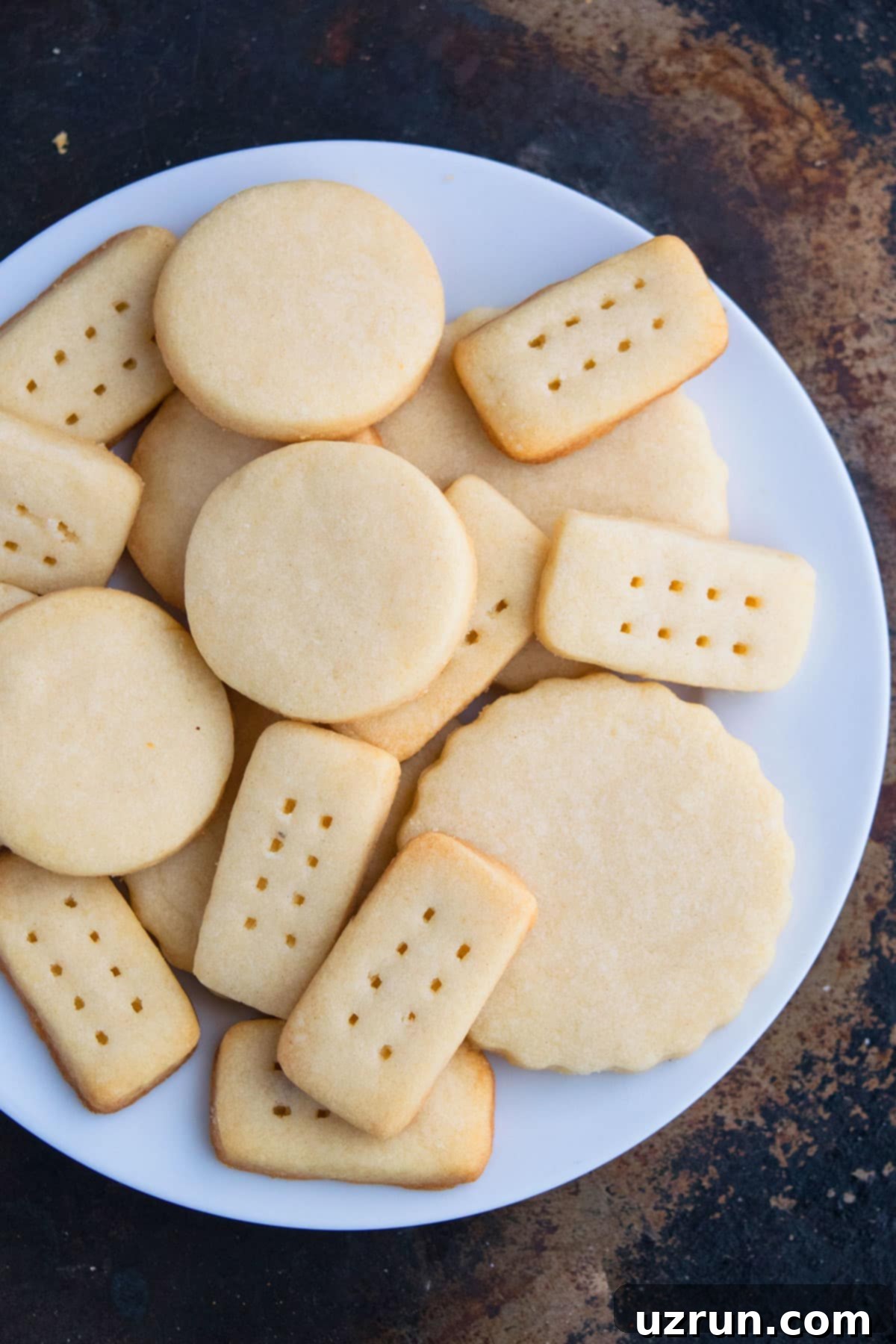
Common Questions About Shortbread Cookies
While both are popular butter-based cookies, their textures and ingredient compositions are quite distinct. Shortbread cookies are characterized by their wonderfully soft, crumbly, and melt-in-your-mouth texture, primarily due to their high butter content and the absence of leavening agents (like baking powder or baking soda) and eggs. They are typically dense and rich. In contrast, sugar cookies often have a firmer, chewier, yet still soft texture. They usually contain eggs and a leavening agent, which gives them a slightly lighter and more cake-like crumb, and allows them to spread more during baking. The higher butter-to-flour ratio in shortbread is what gives it its unique “short” (meaning crumbly) characteristic. Shortbreads have a soft and crumbly texture because of the large quantity of butter whereas sugar cookies are firm, soft and sometimes chewy. The latter also has baking powder or baking soda to help it rise.
No, this classic shortbread cookie recipe does not call for eggs. Authentic shortbread recipes traditionally omit eggs, relying solely on the rich combination of butter, sugar, and flour to create their signature delicate texture and flavor. The absence of eggs contributes to the crumbly, melt-in-your-mouth quality that shortbread is famous for. Adding eggs would introduce moisture and protein that would make the cookies chewier and more like a standard sugar cookie, altering the desired shortbread characteristic. No, they do not have eggs. They are only made with butter, sugar and flour.
Absolutely not! It is completely normal and indeed expected for shortbread cookie dough to appear quite crumbly. This dry, sandy texture is a hallmark of traditional shortbread, indicating the high butter content and minimal gluten development needed for that tender, “short” crumb. Resisting the urge to add any extra liquid, such as water or milk, is crucial. Introducing additional moisture would change the dough’s consistency, activate more gluten, and ultimately result in a tough, uncharacteristic cookie rather than the desired soft and crumbly shortbread. No. This cookie dough is supposed to be crumbly. Do not add water or milk to thin it out because it will change the texture.
There are a few common reasons shortbread might spread more than desired. Firstly, your butter might have been too warm or even partially melted, causing the dough to lose its structure before baking. Secondly, an inaccurate flour measurement (too little flour) can lead to a dough that’s too wet. Lastly, not chilling the dough (if your recipe or environment calls for it) can also contribute to excessive spreading. Always ensure your butter is at room temperature but still firm, measure ingredients precisely, and consider a brief chill for the dough if it feels overly soft.
Yes, shortbread is an excellent candidate for make-ahead baking! You can prepare the dough, wrap it tightly in plastic, and refrigerate it for up to 3-5 days. Alternatively, you can freeze the raw dough (either as a log or already cut into shapes) for up to 2-3 months. When ready to bake, simply slice and bake from a log (adding a few minutes to the baking time), or thaw the cut-out shapes slightly before baking as directed. Baked shortbread also stores incredibly well, making it perfect for preparing in advance for gifts or gatherings.
Storage Instructions for Freshness
Proper storage ensures your homemade shortbread cookies remain delightfully fresh, buttery, and crumbly for as long as possible. Here’s how to store them, whether baked or as dough:
- Make Ahead (Dough): Shortbread dough is fantastic for preparing in advance. You can wrap the unbaked dough tightly in plastic wrap (or form it into a log for easy slicing later) and store it in the refrigerator for up to 3-5 days. If you want to store it longer, the dough can be frozen for up to 2-3 months. Thaw frozen dough in the refrigerator overnight before rolling and cutting, or slice and bake logs directly from frozen, adding a few extra minutes to the baking time.
- Room Temperature (Baked Cookies): Once fully baked and completely cooled, store your shortbread cookies in an airtight container at room temperature. A cookie jar or a sealed plastic container works perfectly. Stored this way, they will maintain their delicious flavor and texture for up to 1 week. Be sure they are completely cool before storing to prevent condensation, which can make them soggy.
- Refrigerate (Baked Cookies): While not strictly necessary for plain shortbread, if you live in a very warm or humid climate, or if your cookies contain fillings or frostings that require refrigeration (like cream cheese frosting or fresh fruit jam), you can store baked shortbread in an airtight container in the refrigerator for up to 10 days. Bring them to room temperature before serving for the best texture.
- Freeze (Baked Cookies): Shortbread cookies freeze exceptionally well! Once completely cooled, arrange them in a single layer on a baking sheet and freeze until solid (this prevents them from sticking together). Then, transfer the frozen cookies to an airtight freezer-safe bag or container, separating layers with parchment paper. They can be frozen for up to 2-3 months. Thaw at room temperature for a few hours before serving.
More Classic Cookies You’ll Love
- Easy Stained Glass Cookies
- White Chocolate Macadamia Nut Cookies (Soft and Chewy)
- Peanut Butter Chocolate Chip Cookies (Soft and Chewy)
- Classic Snickerdoodles Cookies
- Chocolate Thumbprint Cookies
Recipe Card: Easy 3-Ingredient Shortbread Cookies
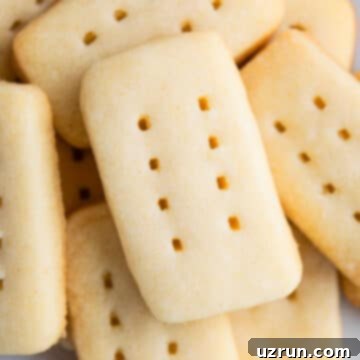
Easy Shortbread Cookies
Abeer Rizvi
Pin Recipe
Want to Save This Recipe?
Enter your email & I’ll send it to your inbox. Plus, get great new recipes from me every week!
By submitting this form, you consent to receive emails from CakeWhiz
Ingredients
- 1.5 cups Butter Salted, Room temperature
- 1 cup Powdered sugar
- 3 cups All-purpose flour
Instructions
-
In a large mixing bowl, cream together butter and powdered sugar until light and fluffy.
-
Add all-purpose flour and mix until just combined. The cookie dough will be very soft and crumbly. That’s the way it’s supposed to be!
-
Now, you have 2 options: 1) Spread mixture evenly on a cookie tray, lined with parchment paper. Poke decorative holes with a fork and bake OR 2) Make cut out shapes like I did by lightly kneading the dough a little and then rolling it between 2 sheets of wax paper. Then, use cookie cutters (like a small rectangle cutter) to cut out shapes. Use a spatula to gently pick them up and place them on a cookie tray, lined with parchment paper and bake.
-
Bake at 325 degrees F (160 degrees C) for 12 to 15 minutes or until edges are firm and slightly golden brown.
-
If you went through option 1, remove tray from oven and quickly use a sharp knife to cut rectangle slices while still warm. Let the cookies cool down completely then remove from tray and enjoy. If you went through option 2, remove tray from oven and allow the cookies to cool down completely. Then, enjoy!
Notes
- Read all my tips and techniques above for best results.
- Leftovers can be stored in a sealed cookie jar or airtight container at room temperature for up to 1 week. Shortbread also freezes beautifully for longer storage.
Nutrition
An automated tool is used to calculate the nutritional information. As such, I cannot guarantee the accuracy of the nutritional information provided for any recipe on this site.
